Mastering Google Ads Campaign Settings: An Ultimate Guide
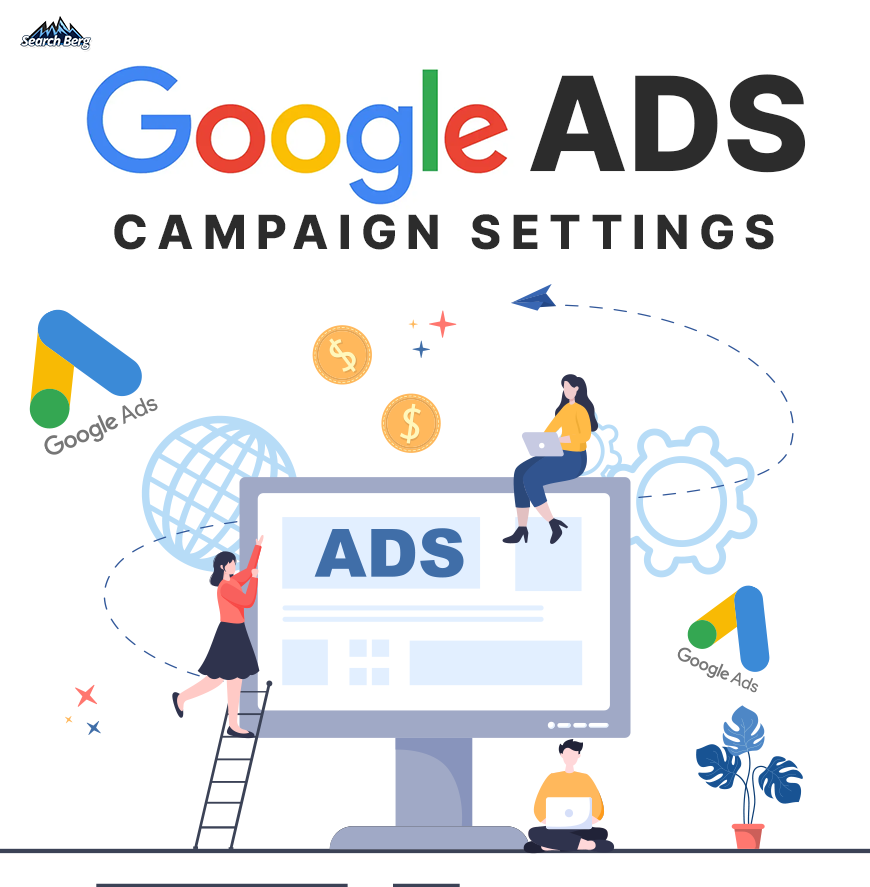
Ah, the life of a small to medium-sized business owner. You wear countless hats throughout the day: CEO, financial manager, salesperson, and everything in between.
Now, add the title of ‘digital marketer’ to the list, and things can quickly become overwhelming.
You’ve probably heard it a million times: “You need to be on Google Ads!” But diving into the platform can feel like being handed the controls to a cockpit without a flight manual. Every setting, knob, and dial can influence the results. There’s no room for error (especially since your hard-earned money is on the line).
This is why understanding Google AdWords campaign settings isn’t just some box to check. This critical step will ensure your advertising efforts translate into real customers and real growth.
Let’s turn that overwhelming cockpit into a comfortable driver’s seat, shall we? Join us as we demystify ad settings on Google!
1. Why Bother with Google Ads?
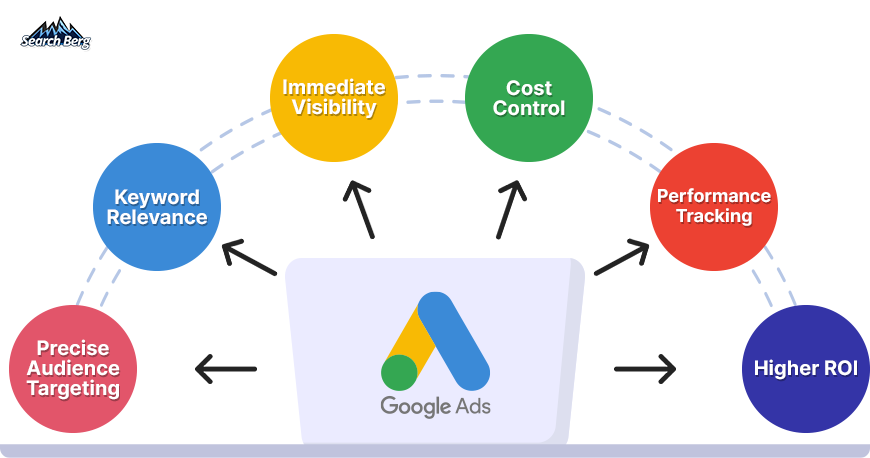
In the bustling digital marketplace of the 21st century, small to medium-sized business owners find themselves competing on a playing field vastly different from the local bazaars and main streets of yesteryears. It’s not just about providing a fantastic product or stellar service anymore. It’s about making sure people know about it.
And where are people? Online. Specifically, on Google, where countless potential customers type in queries every day in hopes of finding answers and solutions.
What Google Ads achieves is nothing short of impressive. It single handedly places a high-performance microphone in front of you to ensure your message reaches your audience loud and clear.
Instead of just hoping someone stumbles upon your store or hears about you from a friend, you’re given the power to introduce yourself, share your story, and say, “Hey, I’ve got exactly what you’re looking for.”
Yet, Google Ads isn’t just about volume; it’s about precision. It’s not merely about being seen; it’s about catching the right people’s attention.
For a local baker, this might mean reaching a young couple in town searching for a custom wedding cake. For a software startup, it could be connecting with businesses on the hunt for unique solutions.
The beauty of Google Ads? Its ability to understand intent and ensure your ads aren’t just cast into the digital abyss but presented to those genuinely interested. But navigating the vast waters of the digital marketplace with Google Ads is just the beginning. Google Ads can be rather daunting.
Small to medium-sized business owners often end up asking themselves: Am I setting this right? Am I maximizing my ROI? Am I reaching my ideal customer?
How can you answer these questions and uncertainties? By learning and mastering the Google AdWords campaign settings ropes. We’ll help you do just that today!
Recommended Read: 2023 Google Ads Guide: 5 Essential Best Practices
2. Why Are Ad Settings on Google So Important?
Think of Google Ads campaign settings as the foundation your campaign stands on. A shaky foundation, and the results will be less-than-pleasing. A sturdy one, and you’re in for a stellar outcome.
For starters, Google Search campaign settings help businesses narrow down and pinpoint their audience with laser precision.
Whether you want to target your audience by region, language, device, or even time of day, you can conveniently do so without so much as a sigh. This means a local café in Brooklyn can specifically target coffee lovers within a five-mile radius.
Every business understands the weight each dollar carries. Ad settings on Google offer control over how your advertising budget is spent. Want to allocate more funds to a particular successful ad? Or perhaps limit spending on another that doesn’t perform as well during weekdays? The settings help you spend wisely.
Google AdWords campaign settings also offer a dashboard to swiftly adapt to these changes. Is there a sudden spike in interest in a particular product due to a viral trend? Adjust your settings to capitalize on that. A local event causing a surge in searches? Tailor your ads to cater to that audience.
See what we mean?
It’s also worth noting that the Google Search campaign settings aren’t just about pushing your ads out. They also provide valuable feedback. By analyzing which settings yield the best results, businesses can continually refine their strategies. It’s like having a conversation with your audience where they tell you what they like and what they don’t (through data, that is).
3. How to Access and Manage Google Ads Campaign Settings
Now that we’ve walked you through the basics, it’s time to dig deeper. How can you access and manage campaign settings to ensure your ads are optimized for success? Let’s pave the way.
3.1. Sign In & Home Base
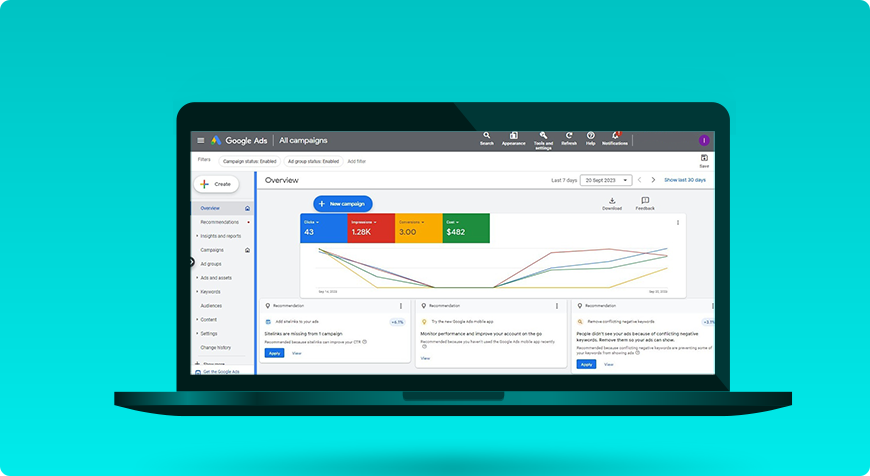
First things first. Head over to Google Ads and sign in using your account credentials. Once logged in, you’ll land on the main dashboard. This is your home base; it gives you an overview of your ad performance, budget, and more.
3.2. Select Your Campaign or Start a New One
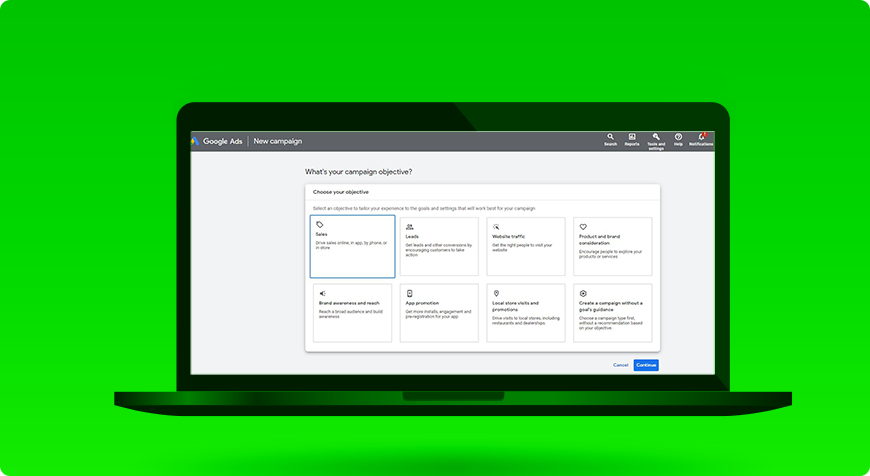
On the left-hand side, you’ll see a menu. Click on ‘Campaigns’. This will display a list of all your active and paused Google Search campaigns. Simply select the campaign you wish to adjust by clicking on its name. You can also start a new campaign, and Google Ads will prompt you to choose an objective for it, as seen above.
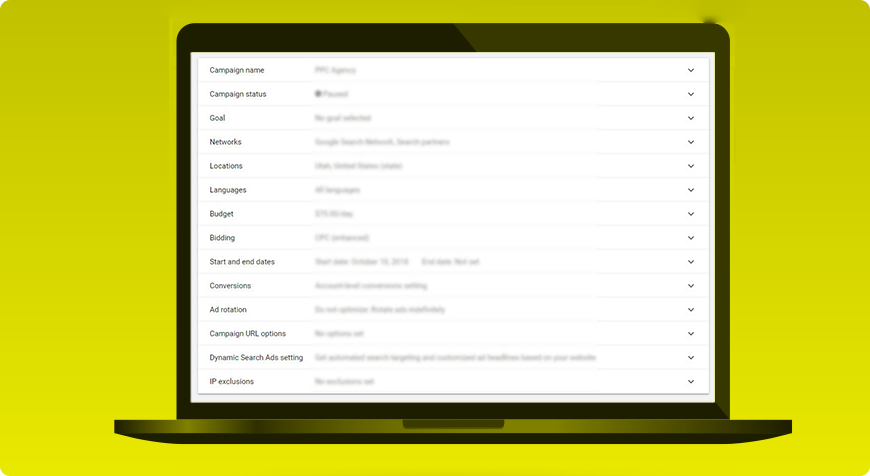
Once your desired campaign is selected, you’ll see a secondary menu appear beneath the main one. Click on the ‘Settings’ tab. This is the gateway to all the adjustable parameters for your campaign.
3.4. Edit
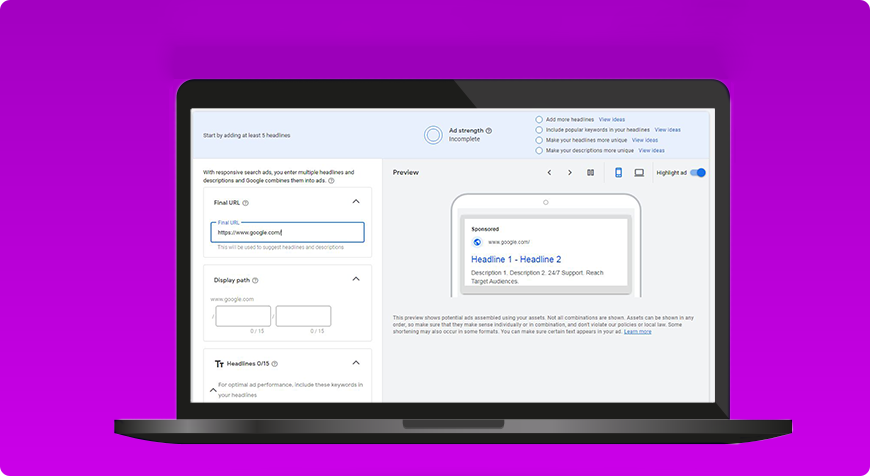
There are two ways to edit your campaign. If you wish to change the settings for a single campaign, navigate to the respective campaign until the pencil icon appears. Click on it and adjust away.
If you want to adjust the same setting for multiple campaigns, check the boxes next to the respective campaigns. Click on ‘Edit’ and proceed.
3.5. Apply
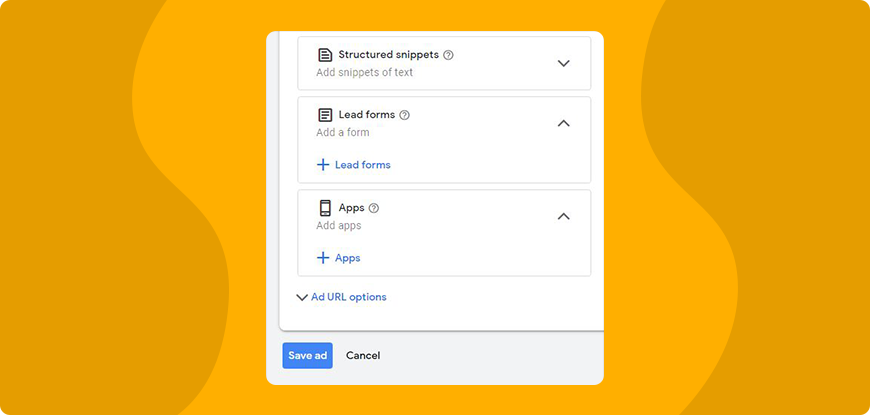
All done? Hit ‘Apply’ and you’re good to go! You can also tweak a particular ad, as seen above.
4. Dissecting Google Ads Campaign Settings
By now, you should be able to independently adjust Google AdWords campaign settings. However, this isn’t just about being able to put two and two together; it’s about solving complex equations.
Sure, you can tweak a setting here and there, but you can’t make magic happen without understanding each setting in detail. Want to reap the benefits of seamless Google Ads management? You’ll have to master a few ropes beforehand.
Let’s break down the intricacies, shall we?
4.1. Campaign Name
When you’re ready to venture into the world of Google Ads, one of the first settings you’ll encounter is the ‘Campaign Name’.
It may sound trivial compared to some of the more intricate settings we’ll discuss later, but naming your campaign appropriately is a foundational step that shouldn’t be overlooked.
The campaign name isn’t for your audience; it’s solely for you and your team. Your customers won’t see this name. Think of it as a backstage pass that guides you through the various campaigns you run.
Why does it still matter? Well, for the sake of efficiency and time-saving. When managing multiple campaigns, a clear name helps you instantly identify which campaign serves which purpose.
If you’ve ever wasted time clicking in and out of vaguely titled documents or folders on your computer, you’ll understand the frustration of not knowing which campaign is which in Google Ads.
If you’re working in a team, clear campaign names also help prevent confusion. Your teammates shouldn’t have to decrypt a campaign’s objective solely based on its performance metrics.
A good campaign name should be self-explanatory. If your campaign is about summer shoes for a 2023 collection, “Summer Shoes 2023” is infinitely clearer than just “SS23”. If your campaign aims to raise brand awareness rather than drive sales, consider naming it “Brand Awareness – Product X” to differentiate it from your sales campaigns. If you have a series of campaigns for different seasons, stick to a format, e.g., “Spring Sale – 2023”, “Summer Sale – 2023”, and so on.
Catch our drift? Before you dive into Google Ads management, check this box off the list. This may be the most basic ad setting on Google, but it’s just as important as the remaining settings.
4.2. Campaign Type
When you initiate a Google Ads journey, you must select the type of Google Search campaign that will best cater to your advertising objectives and brand strategy.
The campaign type you choose will influence where and how your ads are displayed. Let’s delve deeper into the various campaign types available in Google Ads.
4.2.1. Performance Max Campaigns
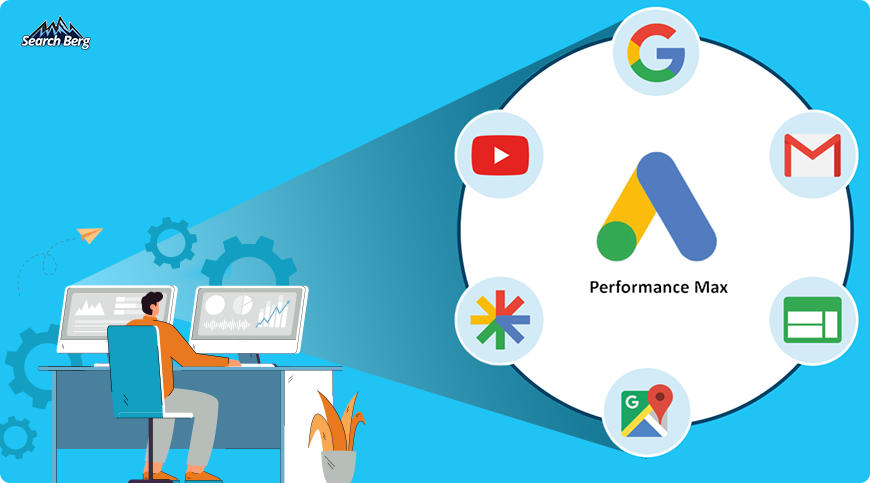
Performance Max Campaigns were introduced with a singular vision: to help advertisers tap into available Google Ads inventory from a single unified campaign.
Performance Max offers a consolidated solution to the problem of managing separate campaigns across different platforms. This means that a brand can showcase its ad across YouTube, Google Display Network, Search, Gmail, and even the Discover feed. There’s no need to set up multiple campaigns.
The true power of Performance Max Campaigns lies in Google’s cutting-edge AI capabilities. As the digital advertising sphere becomes more saturated, businesses have been struggling to continually optimize their ads. Performance Max puts real-time optimization at the forefront.
Let’s say a footwear brand aims to promote its latest line of sports shoes. If the Display Network generates more conversions in the morning, while YouTube ads excel in the evening, Performance Max will dynamically adjust ad distribution accordingly. This ensures that every advertising dollar is used optimally.
The ‘Combinations’ report is another noteworthy feature. With a multitude of ad assets at their disposal, businesses often ponder which combinations will resonate the most with their audience. This report demystifies that aspect by revealing how top-performing assets are amalgamated.
Let’s say a new tech startup launches an innovative smartwatch. They can use Performance Max to cast a wide net initially and advertise across all available platforms.
As data streams in, the startup may notice a surge of interest from tech enthusiasts frequenting specific blogs on the Display Network or specific video content on YouTube. Performance Max, with its AI-driven insights, will automatically allocate more resources toward these high-converting channels.
Work with a Google Ads service provider to use this campaign judiciously. If you’re new to Google Ads management, understanding the importance of this campaign will go a long way in helping you achieve stellar results.
You may feel tempted to hand this task over to your in-house team. However, as we mentioned, a professional Google AdWords management service is your best call.
4.2.2. Search Campaigns

Search Campaigns are considered one of the most immediate and direct methods to engage potential customers. As the name suggests, Search Campaigns allow advertisers to show their ads on Google’s search results page.
Businesses get a chance to position their brand, product, or service front and center when users are actively looking for related information.
Keyword targeting is a pivotal component of this Google Search campaign. Advertisers select keywords they believe potential customers may use to find their products or services.
For instance, a local bakery may target keywords like ‘best chocolate cake near me’ or ‘wedding cakes in NYC.’ When a user’s search matches or is related to these keywords, the bakery’s ad has a chance of showing up.
The structure of the ad is critical. A standard search ad comprises a headline, display URL, and description. Crafting a compelling headline that matches the user’s intent can significantly improve click-through rates.
The description, meanwhile, should provide additional information and a call-to-action (CTA) that prompts users to take the desired step (e.g., visit a website, make a purchase, sign up for a newsletter, etc.).
Search Campaigns stand out for their immediacy. Since these ads target users actively searching for related content, the chances of engagement are considerably high. This is why many businesses achieve a higher return on investment (ROI) with Search Campaigns compared to other advertising methods.
It’s also worth noting that advertisers have complete control over their budget, bidding, and ad display times. The outcome? Precise campaign optimization.
Want to become a pro at Google Ads maintenance? Take some time to understand, learn, and master this particular campaign. A firm foundation will help you reel in impressive profits.
4.2.3. Display Campaigns
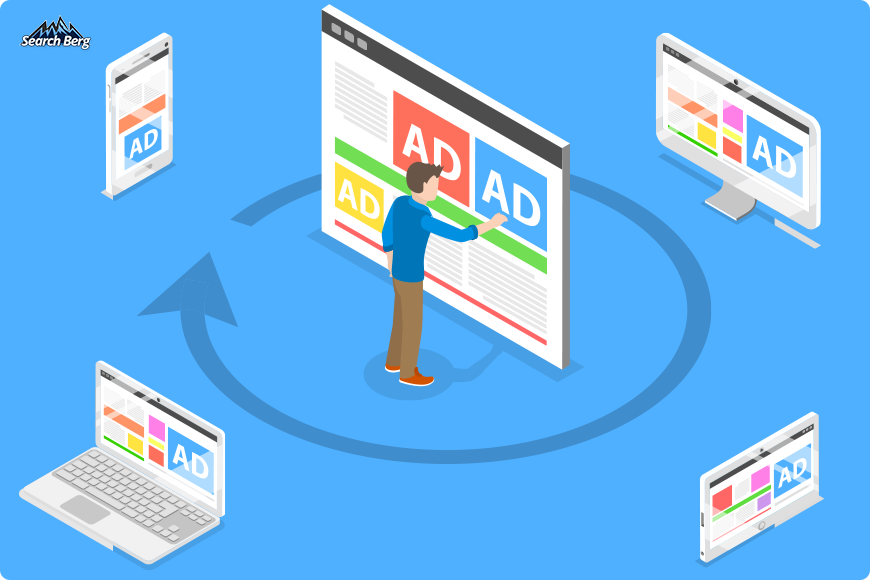
Display Campaigns are a different beast altogether. Instead of waiting for a user to type a query, Display Campaigns proactively place ads across a vast network of websites.
They brilliantly offer visual content ranging from simple banners to interactive multimedia. This network, often referred to as the Google Display Network (GDN), encompasses millions of websites, apps, and even videos.
Display Campaigns primarily use images, animations, and graphics to engage users. They’re more proactive as they show ads based on various targeting methods like audience interests, demographics, or even retargeting strategies.
One of the powers of Display Campaigns is the plethora of targeting options available. Advertisers can target users based on their interests, the content of websites they’re browsing, or even past interactions with the advertiser’s website (retargeting).
For example, a travel agency might display their ads on travel blogs, forums, or any website where users are reading about vacations. It’s quite simply genius.
4.2.4. Video Campaigns
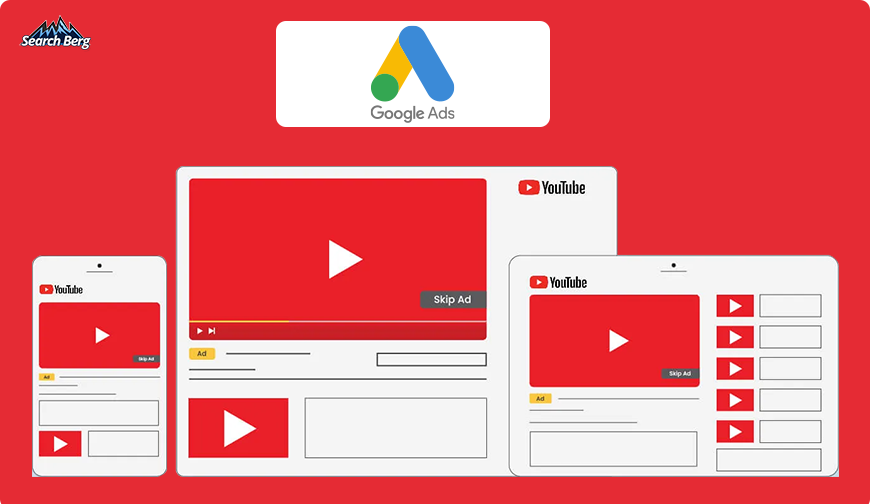
There’s no denying that attention spans are at an all-time low. Video content has emerged as one of the most engaging mediums that manages to hold people’s attention.
Video Campaigns leverage this power. Advertisers can convey their message, tell a story, or showcase a product in a dynamic and immersive way.
This Google Search campaign primarily runs across platforms like YouTube, but it’s not confined there. Video Campaigns can also place ads within videos on various partner websites and apps in the Display Network. These can range from short bumper ads, which last just a few seconds, to longer, skippable ads that play before, during, or after a video.
There are several formats to choose from. Bumper ads are brief and aim to capture attention quickly. Skippable in-stream ads play before a video and can be skipped after five seconds. Then, there are non-skippable in-stream ads, which viewers must watch before accessing their chosen content.
The variety ensures advertisers can pick a format that aligns best with their goals.
Much like other Google AdWords campaigns, Video Campaigns offer precise targeting options. Advertisers can display their ads based on user demographics, interests, search history, and more. Moreover, the interactive nature of videos allows for direct engagement.
Crafting a compelling video is just one piece of the puzzle; knowing when to air it, who to target, and how to allocate the budget are equally critical steps. Google Ads service providers continuously stay updated with the platform’s evolving features and can adeptly utilize tools like TrueView in-stream ads, bumper ads, and more to maximize ROI.
When you sign up for ads management services, you’ll work with experts who can analyze metrics in real time, tweak campaigns for better performance, and ensure you get the most bang for your buck.
4.2.5. App Campaigns
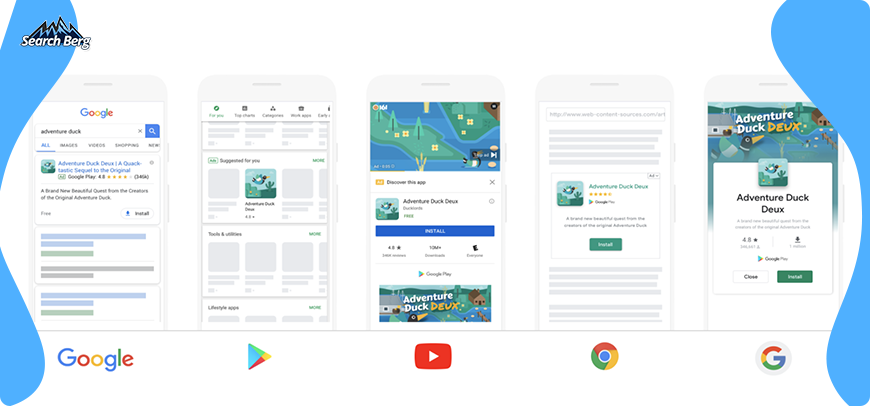
App Campaigns offer a streamlined way to promote mobile apps across Google’s vast suite of platforms, including Search, Play Store, YouTube, Discover, and over three million partner sites and apps. The primary goal is to find new app users and boost in-app conversions.
App Campaigns leverage Google’s machine learning capabilities to test a range of ad asset combinations and automatically identify the top-performing variations to reach the advertiser’s goals (e.g., app installations, engagement, or in-app actions).
By simply providing text ideas, images, and videos, the system crafts ads tailored to meet the ad spaces and the audience’s preferences.
For example, let’s say a gaming company launches a new mobile game. By using App Campaigns, they can easily promote their game to a broad audience, entice gamers on YouTube with trailers, catch their attention on Google Search when they look for a new game, or showcase the game’s features on partner apps and sites.
The gaming company only needs to set their budget and bidding strategy. Google’s algorithms handle the rest! They ensure the ads reach potential players most likely to download and engage with the game.
Optimizing your app’s exposure doesn’t end once the campaign is up and running. Proper Google Ads management and maintenance play pivotal roles in ensuring your App Campaign succeeds.
By delving into the ad settings on Google, you can refine targeting preferences, adjust demographic details, or even tweak geographic preferences to ensure the app reaches the most receptive audience segments.
This granular control becomes increasingly vital with shifting user behaviors and market trends. Periodic adjustments made by experienced Google Ads service providers will go a long way in maintaining campaign effectiveness.
4.2.6. Local Campaigns

Local Campaigns are designed with brick-and-mortar businesses in mind. These campaigns automatically use Google’s machine learning capabilities to optimize ads across multiple platforms: Search, Display, Maps, YouTube, and more. The primary goal is to generate foot traffic and elevate in-store sales.
To launch a Local Campaign, advertisers provide the business locations they wish to promote, a budget, and ad assets. The system does the rest! The campaign dynamically uses the ad combinations to display optimal ads to users in proximity or those expressing interest in the local area (or similar products and services).
For instance, a local coffee shop could use Local Campaigns to entice nearby residents. When someone in the vicinity searches for ‘coffee near me’ on Google, they could see an ad for the coffee shop. Simultaneously, a user browsing a blog may see a display ad promoting the shop’s newest espresso blend. Or someone using Google Maps might get directions to the shop.
Local Campaigns draw customers to a business’s doorstep, enhance their in-store experiences, and boost sales.
Understanding and adjusting the ad settings on Google can profoundly impact the success of Local Campaigns. While Google’s algorithms manage much of the process, taking a hands-on approach by delving into Google AdWords campaign settings can offer deeper customization.
For instance, advertisers can refine audience targeting, select specific demographics, or even narrow down geographic preferences. This tailored approach ensures that the Local Campaign resonates more strongly with the intended audience.
Partnering with a Google AdWords management service or an experienced Google ads service provider is often the key to unlocking a campaign’s full potential. These experts are equipped with the tools and expertise needed to navigate the nuanced settings of a Local Campaign. Their grasp of Google search campaign settings allows for the enhancement of a campaign’s visibility and engagement.
While Local Campaigns’ automation aspect offers simplicity, adding a layer of expert human insight can be the differentiating factor between a good campaign and a stellar one. Engaging with professionals ensures that the campaign isn’t just set and forgotten; instead, it’s continually optimized, monitored, and refined to achieve the best outcomes.
4.2.7. Smart Campaigns
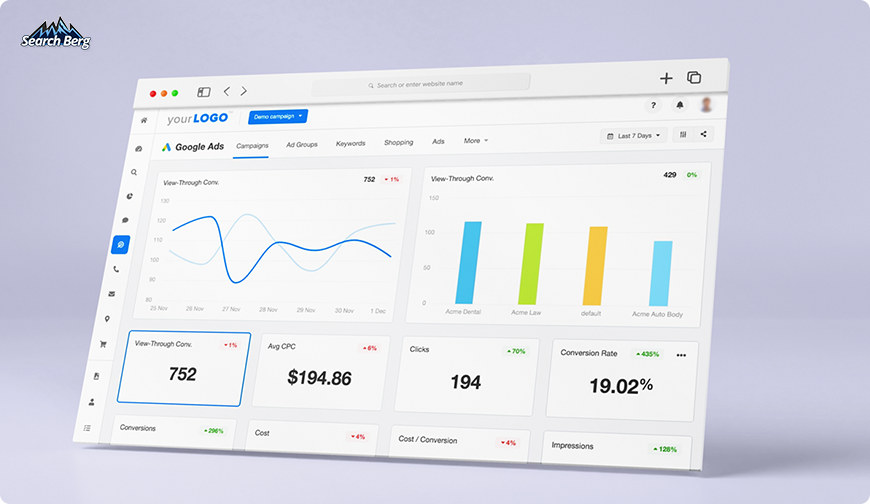
Smart Campaigns represent the next level of simplicity and automation for advertisers, especially small businesses looking for an uncomplicated introduction to online advertising.
Tailored for those who may not have the time or resources to dive deep into the nuances of ad management, Smart Campaigns automate the majority of the ad creation process.
The built-in Google AI handles everything, including optimizing targeting to reach the most relevant audience, setting bids to maximize the budget, and even deciding where the ads should appear.
The primary goals here are sales, leads, and website traffic. The automation ensures advertisers achieve these outcomes with minimal manual input.
Let’s say a local bakery wants to attract more customers. With Smart Campaigns, they can set up ads within minutes and start promoting their specialty pastries. Google’s algorithms would then determine when and where these ads should be displayed for optimal engagement. Pretty neat, right?
While Smart Campaigns provide ease for advertisers, especially novices, you must still develop a good grasp of Google Ads preferences. Advertisers can fine-tune their preferences based on their understanding of the target audience and market dynamics. This allows them to steer the campaign subtly in a direction that aligns more closely with their specific objectives (even within the automated framework).
Additionally, by periodically revisiting and adjusting these preferences, businesses can adapt to changing market conditions or strategic shifts.
4.2.8. Shopping Campaigns
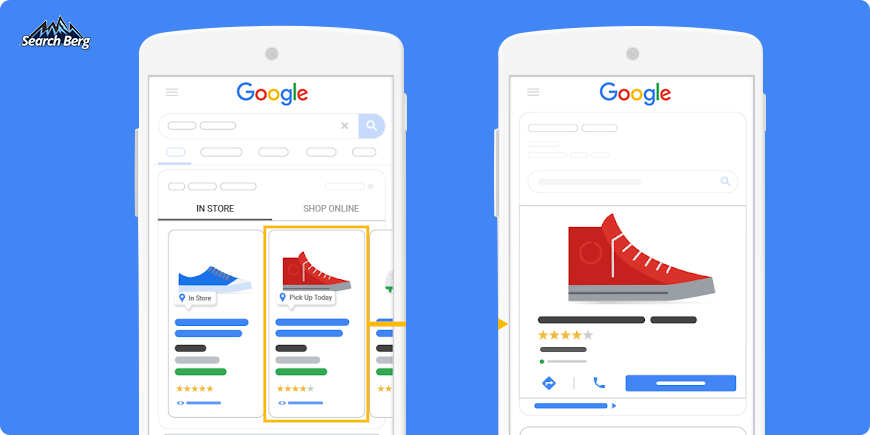
Shopping Campaigns are the go-to choice for retailers aiming to showcase their products directly within the Google ecosystem.
These campaigns use product information from the Merchant Center to display product listings on Google Search, the ‘Shopping’ tab, and even on partner websites. They often display product images, prices, and the store name.
Shopping Campaigns stand out for their interactive nature. Users can see the product’s price and image before they even click on the ad; retailers can also employ local inventory ads within Shopping Campaigns to highlight products available at their brick-and-mortar locations.
To harness the full power of Shopping Campaigns, retailers must set up a Merchant Center account and regularly update their product feed. This ensures that product listings are current, relevant, and aligned with what’s actually in stock.
In the context of Shopping Campaigns, utilizing the full spectrum of Google Search campaign settings can make a profound difference in ad performance. By meticulously adjusting these settings, retailers can decide when and where their product listings will be displayed.
This is a great way to ensure the listings gain optimal visibility and are presented to the most relevant audience segments. Keeping a keen eye on these settings, especially in the ever-evolving eCommerce landscape, can help retailers stay ahead of the competition and market dynamics.
We also recommend enlisting the help of Google Ads management professionals to take campaign performance to new heights. These experts understand the nuances of ad settings in Google and offer valuable insights into bidding strategies, audience segmentation, and ad placement. You’ll end up significantly boosting the campaign’s ROI, driving more sales, and enhancing the overall shopping experience for customers. Who would want to turn these benefits down?
4.3. Networks
Think of the ‘Networks’ setting as your compass; it’ll help you select platforms that resonate most with your target audience based on the campaign type you’ve selected. Google offers two primary networks: the Google Search Network and the Google Display Network. Let’s unpack them!
4.3.1. Google Search Network
Think of the Google Search Network as a vast digital marketplace; it brings together search sites that allow your ads and complimentary product listings to make an appearance.
But it’s not just confined to Google’s search results. Your ad also has the potential to be showcased on auxiliary Google platforms like Google Maps, Google Shopping, and even Google Images.
Further extending its reach, this network incorporates other affiliated websites that have partnered with Google. Collectively, these partner sites form an integral part of the Google Network, a grand tapestry of web pages and applications ripe for ad placements.
Sharpen your understanding of Google Ads preferences to achieve specific business objectives and ensure your ads reach their full potential. By leveraging Google Ads management services, you can navigate the complexities of the Google Search Network with ease and derive maximum value from your advertising investments.
4.3.2. Google Display Network
The Google Display Network is a vast collection of over two million distinct websites, intriguing videos, and interactive apps. And its influence is massive; it touches the screens of over 90% of the globe’s internet-savvy populace.
But it’s not just about sheer numbers. What makes the Display Network truly special? Its unmatched precision in targeting.
Whether you want your ad to resonate with adventure enthusiasts reading about mountain treks, become visible to tech aficionados watching gadget reviews, or make an impression on city dwellers browsing lifestyle blogs, this network has got you covered.
You can fine-tune your ad’s appearance based on context, audience demographics, specific locations, and more. Your message is guaranteed to land in front of the eyes that matter the most!
Successfully navigating the expansive terrain of the Google Display Network requires more than just a basic understanding. It requires an in-depth knowledge of Google AdWords campaign settings to ensure your advertisements hit the mark every time.
By delving deep into these settings, you can exploit the network’s robust targeting capabilities to their fullest. The potential for tailoring is boundless!
Engaging with such a widespread network can sometimes feel overwhelming, particularly when you’re striving for pinpoint precision. This is where a Google Ads service provider steps in as an invaluable asset. They bring expertise in Google Ads management and can provide insights into the myriad of ad settings on Google.
4.4. Devices

Google Search campaigns aren’t just restricted to billboards or TV screens anymore; they’ve evolved tremendously. Today, they’re omnipresent across a diverse range of devices, from the compact smartphones in our pockets to the vast desktop screens on our desks.
The ubiquitous nature of mobile devices means you’re constantly in the hands of your potential customers. Whether they’re scrolling during a commute, browsing before bedtime, or hunting for a product, your ad can appear right there, courtesy of mobile advertising.
This doesn’t just mean text ads; there’s a plethora of options, from image-based promotions to sophisticated HTML 5 ads crafted with tools like Google Web Designer.
And if you think it stops there, think again. Ads also find their home within the apps people spend countless hours on. From simple text and image ads to video promotions and the specialized TrueView for app promotions, the advertising world is as dynamic as the apps themselves.
And for businesses that thrive on direct communication, call-only ads ensure they’re only shown on devices that can connect you straight to a customer’s call.
All your campaigns and text ads are prepped to run on most mobile devices. However, if you’re aiming for exclusivity, like avoiding ads on tablets, you have the freedom to set a negative device bid adjustment. And no, this won’t make Google Ads management trickier.
As for the technical side of things, mobile image ads have their specificities. For instance, the ideal sizes range from 320 x 50 to the more immersive 336 x 280 interstitials on mobile phones. Tablets play well with sizes ranging from 300 x 250 to the expansive 336 x 280 interstitials.
4.5. Locations and Languages

Want your ads to be seen by the right eyes and ears? Using location and language settings is your answer.
These Google AdWords campaign settings help pinpoint the exact geographical areas where your ads will be displayed. Additionally, by selecting the appropriate language, you can ensure your ads show up on Google platforms and affiliated websites in languages familiar to your audience.
Let’s say you run a business in Norway. By targeting Norway as the location and Norwegian as the language, you’ll ensure your ads appear to customers in Norway who have chosen Norwegian in their browser settings.
The revamped Google Ads experience is set to debut in 2024! Here’s a step-by-step guide to navigating and setting your campaign’s location and language:
- Accessing Campaign Settings
- Log into your Google Ads account and select the ‘Campaigns’ icon.
- Use the drop-down menu in the ‘Campaigns’ section and click on ‘Campaigns’ again.
- To kickstart a new campaign, click on the ‘+’ symbol and then choose ‘New Campaign’.
- Choosing the Location
- You can either pick a location from the options presented or type in a specific location in the search box.
- Setting the Language
- Type and search for your preferred language.
- Check the box corresponding to the language you aim to target.
- Complete the remaining campaign settings and hit ‘Save and Continue’.
You can also change the settings for multiple campaigns at the same time. Click here for instructions. Since this terrain is significantly more complex, make sure you work with a Google Ads service provider. The more settings are introduced, the more complicated Google Ads management becomes. The right help will go a long way in ironing out the kinks.
4.6. Bidding and Budget
The strategies you adopt for bidding and budgeting play pivotal roles in determining whether your campaign succeeds or fails. Let’s delve into the nuances of these strategies and how they can be harnessed effectively.
4.6.1. The Art of Bidding
When it comes to setting bids for clicks on your advertisements, you have a choice to make.
You can either manually define your bids, retaining total control, or entrust Google Ads with the task, leveraging its algorithms to optimize bids for you.
There may be an array of additional bidding alternatives at your disposal based on the nature of your campaign.
At its core, your bid strategy orchestrates the manner in which you shell out money for user interactions with your ads. The bid limit you set acts as a cap; it delineates the maximum amount you’re willing to part with for a single click on ads within a specific ad group.
To ensure your ad spends yield the best results, familiarize yourself with the various bidding options that Google AdWords campaign settings offer. For instance, if you’re aiming to enhance visibility on certain days or during specific hours, you can adjust bids to amplify ad performance during those periods. This kind of precision can make a significant difference in your campaign’s success rate.
4.6.2. Budgeting with Precision
While bids dictate individual interactions, your budget paints the broader picture. It represents the average sum you’re comfortable spending on a daily basis for a particular campaign.
The beauty of budgeting in Google Ads lies in its flexibility. You hold the reins when it comes to determining the amount, and if the need ever arises, you have the freedom to make adjustments to ensure your campaigns align with your financial comfort zone.
The ad settings on Google are thoughtfully crafted to put the advertiser in the driver’s seat. Instead of making you feel constrained, the platform grants you the flexibility to customize spending according to your brand’s needs and ambitions.
This adaptability enables businesses, from startups to enterprises, to employ Google Ads and curate campaigns that resonate with their target audience without overstepping financial boundaries.
However, to truly leverage this flexibility and ensure your budget yields the best return on investment, considering a Google ads service provider can be invaluable.
With specialized knowledge of Google Search campaign settings and hands-on experience, these ads management services aid in refining your budget strategies.
They provide insights into maximizing ad exposure, adjusting to seasonal trends, and optimizing cost-per-click. With seasoned experts by your side, you can rest assured every penny of your budget works effectively toward achieving your advertising objectives.
4.7. Ad Assets
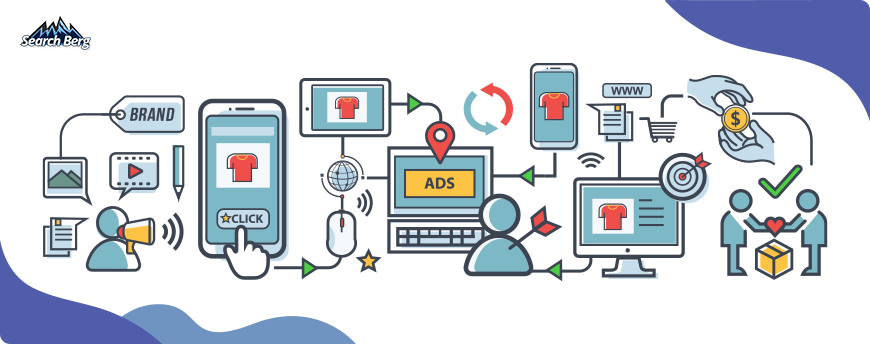
Think of ad assets as your ad’s building blocks. They contain vital business details that make your offerings more appealing and persuade users to gravitate toward your business.
Ad assets can encompass headlines, descriptions, specific website links, interactive call buttons, geographical details, and much more. Together, they craft the ad structure presented to potential customers.
The crux of leveraging assets lies in their flexibility. Google Ads, when dealing with responsive search ads, intelligently decides which supplementary assets to showcase based on individual search queries. This dynamic nature necessitates the incorporation of all pertinent assets corresponding to your business goals.
Enhancing your ads with assets, such as sitelinks and imagery, is a great way to amplify visibility on search engine result pages (SERPs). This heightened prominence often translates to more fruitful interactions and a higher click rate.
While certain assets necessitate manual configuration, others get integrated automatically if Google Ads believes they’ll augment your ad’s efficacy. These are termed automated assets; they streamline the process by negating any need for set-up.
Incorporating extra assets into your campaigns incurs no additional charges. Usual costs apply for clicks on any component of the final ad, whether it’s the headline, sitelink, or image.
Certain interactions, like seller ratings clicks, are exempt from charges. In essence, you only incur costs for meaningful engagements (e.g., when a user initiates a call from your ad or installs your application directly from it).
There’s a cap ensuring you’re not charged for more than two clicks per ad impression.
When deliberating on asset incorporation:
- Integrate all assets pertinent to your enterprise (they’re cost-free and only appear if deemed performance-enhancing).
- Aim to incorporate at least four distinct asset types, such as sitelinks, callouts, visuals, etc.
- If appropriate, design assets at elevated account tiers.
- Certain read-only asset types may not be displayed but could still be operational.
Ad assets are invaluable tools in the realm of digital advertising; they facilitate enriched user interactions and drive optimal outcomes. Proper understanding and adept utilization can prove pivotal in achieving advertising success.
As the digital advertising landscape becomes more sophisticated, the sheer variety of ad assets available in ad settings on Google can appear daunting. While the integration of assets is pivotal to campaign success, their selection, configuration, and ongoing optimization require a strategic approach.
This is where a Google ads management service becomes indispensable. With their expertise in Google AdWords campaign settings, Google Ads service providers can offer recommendations on which assets resonate most with your target demographic to ensure your campaigns are always primed for maximum engagement.
As ad assets evolve and newer formats emerge, expert-led Google Ads maintenance ensures your campaigns remain fresh and competitive. With the right assets in place, advertisers can expect enhanced visibility, meaningful engagements, and a significant uptick in conversion rates.
4.8. Additional Settings
To enhance your campaign’s performance, Google Ads offers a suite of auxiliary settings. These tools grant advertisers the discretion to shape when and how their ads appear to potential customers.
4.8.1. Campaign Schedule
This tool permits advertisers to earmark specific commencement and culmination dates for their campaigns. It’s a great way to ensure ads are only displayed during the designated timeframe.
4.8.2. Ad Timing and Frequency
Have you ever wondered if there’s an optimal time to display your ads? ‘Ad Scheduling’ helps you make that call!
Whether you want your ads to be on display continuously, only on particular days, or strictly during business hours when you’re equipped to address customer queries, this feature grants you complete leeway to make adjustments as you deem fit.
The default modus operandi for Google Ads is to exhibit your advertisements when they stand the highest probability of eliciting clicks or conversions. Yet, for those who prefer a consistent ad presence throughout the day, there’s an option to distribute ads more uniformly.
4.8.3. Location-Centric Features
‘Advanced Location Options’ are available for those who wish to fine-tune their ad display based on geographical considerations.
4.8.4. URL Preferences for Campaigns
‘Campaign URL Options’ allow for enhanced customization in how your ad’s URLs are structured and displayed.
4.8.5. Bidding Adjustments
When scheduling your ads, you’re also presented with the liberty to regulate bid amounts. You can opt to increase or decrease your bids for specific days and time slots (depending on when you perceive the maximum engagement potential).
Let’s quickly look at this setting in action. Imagine you operate a boutique cafe known for its exclusive weekend brunch menu in NYC. After analyzing the ‘Day and Hour’ metrics on the Ad Schedule page, you observe a spike in interest for your ads between 10.00 a.m. and 1.00 p.m. on Sundays when a popular morning lifestyle show, ‘City Bites,’ airs on local television.
You immediately recognize this trend and start fine-tuning your ad schedule. Now, your ads specifically target the brunch crowd during peak interest hours on Sundays. How does this benefit you? Stellar engagement, more calls and visits to your business, and sweet profit.
See how this works?
These supplementary settings are pivotal tools in an advertiser’s arsenal. They pave the way for campaigns to become better aligned with business objectives. The outcome? A higher ROI. You can also rest assured your ads reach audiences at the most opportune moments!
Fire Up the Google Ads Cannon!

This was quite the journey, right? Well, we’re just getting started! Now that you have a tight grasp of ad settings on Google, it’s time for the real work to begin.
At Search Berg, we specialize in Google Ads management. We set up, optimize, and manage your advertising campaigns to help you reach your target audience, make bigger and better sales, and grow your business.
If you think Google AdWords campaign settings are far too complex for you to traverse alone, leave the work to experienced Google Ads service providers who know the ins and outs of the platform.
Our team will roll up its sleeves, dive deep into the complexities, and help you stand out in your industry.
It’s showtime!












